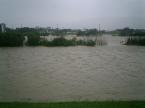
I opened the latest Environment Waikato news update to discover that a Regional Policy Statement (RPS) is due, ten years after the last one. As I thumbed through the publication a heading leapt out at me: “Our climate is changing, so we must too.” Underneath came this statement:
“Even if all greenhouse gas emissions were stopped now, we will still be affected by greenhouse gas emissions already in the atmosphere, and will need to adapt to changes for generations to come.”
Following paragraphs mentioned some of the specifics for our region. It was comprehensive. Agriculture and forestry, our major commercial land uses, could be directly affected by climate change and climate policy. We can expect rising sea levels, more extreme weather, more droughts in the east, more intense rain and increased winds in the west, warmer, drier summers, milder winters and shifting seasons, increased risks from natural hazards such as river and coastal flooding, coastal erosion and severe weather.
Examples were then given of the kind of responses Environment Waikato will focus on. Flood management, the use and development of natural resources, planning, building regulations, infrastructure design and location. All sensible and appropriate.
I was pleasantly surprised by the prominence being given to climate change in the policy statement. It is listed as the second of six key issues facing the region, the first of which is the pressure being put on natural resources. The third issue is energy sources, and here again reference to climate change and the need to cut carbon emissions figures strongly. Even in the fourth issue, land use, the question of carbon footprint gets a look in.
Encouraged, I went looking for other regions’ ten-year plans. Not with a great deal of success. However I found Greater Wellington’s which was approved last year. It too identifies climate change as a key issue (page 29). It was more discursive than Waikato’s, and introduces mitigation more prominently. What it seeks:
“A resilient community that, as far as possible, is reducing its greenhouse gas emissions to mitigate the effects of global warming, but is also adapting well to any changes caused by climate change.”
Among the likely changes it points to are increasing drought in the Wairarapa, increases in storm intensity across the region, increased fire danger and the serious implications of sea level rise for coastal areas.
In relation to mitigation measures it finds space to respond to the argument that because New Zealand is so small Wellington shouldn’t worry about reducing its emissions but simply concentrate on adapting to whatever results from the rest of the developed world’s activities:
“The countering argument is that if, to achieve a liveable future, we wish to persuade the rest of the developed world to mitigate the effects of global warming, we only acquire the moral right to do so by doing our bit.”
The counter argument seems to have won out, for the document goes on to set out the response of the regional body to the climate change issue:
“Greater Wellington is currently working with the city and district councils in the region and around New Zealand, and is leading the region’s planning for dealing with climate change. Local authorities have agreed to work collaboratively on developing goals and a shared plan for the region to reduce the region’s greenhouse gas emissions. We will also take the opportunity to develop strategies to support our communities to be resilient and adapt to the effects of climate change.”
It details steps which are under way or planned. Prominent amongst them is the identification of potential renewable energy options for the region, such as marine and solar, and the intention to make Greater Wellington-owned land available for private developers to construct wind farms at Puketiro in the Akatarawa Forest and Stoney Creek in the Wairarapa.
Whether these two regional councils are representative of the long-term thinking of all the regions is unclear. Auckland’s planning is on hold pending the new governance set-up there. Canterbury, the other major centre of population, surprisingly doesn’t seem to address climate change specifically in its draft statement or identify it as a major issue. However, the major attention given to the matter in the Waikato and Wellington statements indicates that it is becoming integrated into their thinking and that they are being guided by the predictions of the science. The Waikato draft notes that New Zealand’s response in terms of actions to reduce climate change is primarily a central government rather than a local government role, but nevertheless expresses some interest in emissions reduction within its bailiwick, particularly in relation to renewable energy generation and more climate-friendly transport. Wellington is quite bullish on the contributions it can make to mitigation as well as adaptation.
It is clearly worth keeping an eye on local government while agonising over the continuing evasiveness of central government. Engagement with adaptation issues locally must surely impress people with the reality of climate change and the need to mitigate further damage. There’s an irony that the Minister of Local Government, Rodney Hide, should be a vocal climate change denier who laments what he describes as the massive costs inherent in climate change policy. He even goes so far as to say that the policy is designed to upend society and stifle industrial processes and progress. Fortunately there are limits to his authority.
Like this:
Like Loading...



